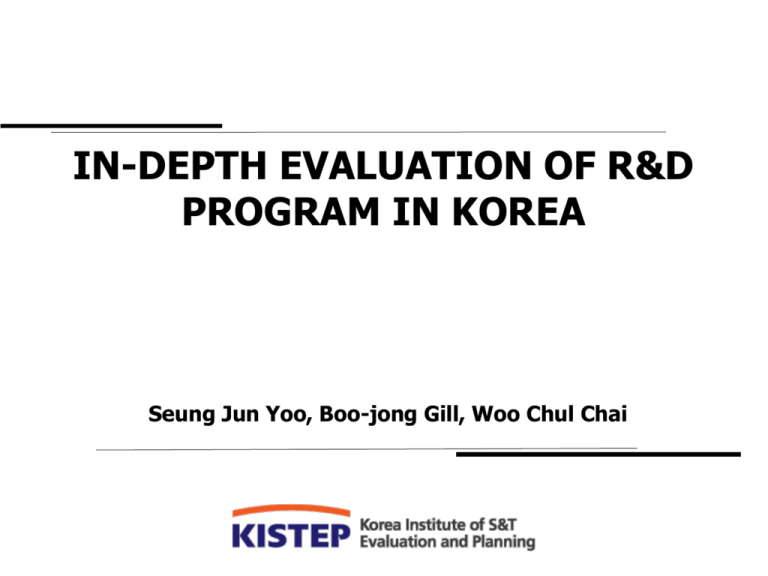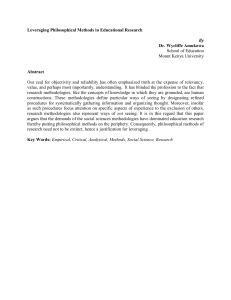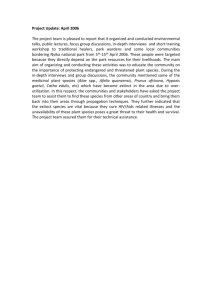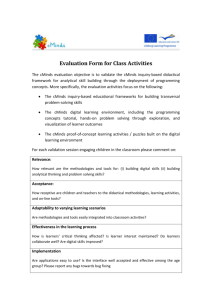National R&D Program Evaluation System in Korea
advertisement

IN-DEPTH EVALUATION OF R&D PROGRAM IN KOREA Seung Jun Yoo, Boo-jong Gill, Woo Chul Chai Contents 1. Overview of Public R&D Program Evaluation 2. Objective 3. Procedure 4. Methodologies 5. Utilization of Evaluation Results 6. Challenges and Discussion 2 Overview of Public R&D Program Evaluation 1 - Players NSTC Report MOSF KISTEP (Evaluator) Evaluation Supporting Groups R&D programs of each ministry MEST MOE Taking Charge of R&D Evaluation and Budget Allocation MKE MIFAFF MW …… Agency Agency Agency Agency Agency 3 *NSTC (National Science & Technology Council), MOSF(Ministry of Strategy and Finance) Overview of Public R&D Program Evaluation 2 - R&D program management process Evaluation strategy & Data collection R&D Budget Survey/Analysis Programs/Projects implemented Evaluation In-depth Self → Meta Corrections* Feedback 4 Recommendations to program ministries Evaluation process Correction process Overview of Public R&D Program Evaluation 3 - Overview of Public Finance Program General Public Finance Programs • SOC, Agriculture, Health/Welfare, National Defense, Industry/Energy, etc. Informatization Programs • Information Infrastructure • Information Utilization & Impact R&D Programs • Science and Technology • R&D Human Resources Development, Infrastructure, etc. 5 6 Overview of Public R&D Program Evaluation 4 - In-depth evaluation & Self/Meta evaluation In-depth Evaluation R&D Program Evaluation - ~ 10 programs with evaluation issues - logic model, evaluation questions, indepth analysis, communications, recommendations, coordination, etc. - depends on evaluation questions Self → Meta Evaluation 7 - 1/3 out of all programs (70 programs out of 207 programs, ‘09) - self evaluation by each ministry meta evaluation by MOSF/KISTEP - depend on indicators with weight Objective of the Evaluation • To increase the efficiency and effectiveness : find out and diagnose the problems at all aspects : improve the program by applying evaluation results 8 Procedure 1 - 4(5) steps 1. Evaluation Strategy 0. Selecting target program 2. Analyze & Interpret 3. Results coordination 4. Utilization of the results 9 • logic model, evaluation questions • data collection plan, methodologies • collect data • data analysis & interpret • interim & final results • interview & coordination • 4 types • management action plan Procedure 2 - 7-month schedule (depends on the cases) - (month 0) : selected by selection committee based on special issues, etc. ¶ In-depth evaluation procedure for selected program(s) - month 1 : form evaluation group, gather program(s) data, study target R&D program(s), find major evaluation questions - month 2 : develop logic model and methodologies - month 3/4 : perform in-depth analysis (relevance, efficiency, effectiveness, program design & delivery, etc) 10 Procedure 3 - month 5 : interview (researchers, program managers, etc.) - month 5 : report interim evaluation result (MOSF, ministries) - month 6 : report final evaluation result & recommendations Large program : ~ 10 months Specific needs for short-term : 2 ~ 3 months (specify the needs → perform evaluation) 11 Methodologies Types of Evaluation Satisfaction Importance-Performance Analysis (IPA) Qualities (Paper, Patent, etc.) Paper : Impact Factor, Times Cited, etc. Patent : Technology Transfer, Value, Citation, Survival Analysis, etc. Policy, Strategy System Dynamics, etc. Portfolio (Investment, etc. ) 12 Methods BCG Growth Share Matrix, GE/McKinsey Matrix, etc. Methodologies_IPA Performance (high) Performance (low) Concentrate Here! Keep Up Good Work! Low Priority! Importance (low) Possible Overkill! Importance (high) Source: Martilla, J. & James, J. C.(1977), Importance-perfomance analysis. Journal of Marketing, 41(1) : 78 13 Methodologies_Survival Analysis Survival Analysis Idea/Pilot Study → Project → Paper ↔ Patent → Technology Transfer Following Study Modified from: DeVol, R. & Bedroussian, A.(2006), Mind to Market: A Global Analysis of University Biotechnology Transfer and Commercialization. Milken Institute 14 Methodologies_System Dynamics Source: Ahn, N. (1999), A system dynamics model of a large R&D program, MIT Press Yoo, S. et al. (2009), In-depth Evaluation of Health & Medical R&D Program in Korea, KISTEP 15 Methodologies_Portfolio Analysis 16 Utilization of Evaluation Results Types of Correction 17 Management Action Improve Program Delivery System Correct the inefficient system in program delivery to achieve the goal(s) of the program more efficiently Coordinate Budget Allocation Increase or cut the budget corresponding to insufficient or unnecessary investment, respectively to achieve the goal(s) of the program more efficiently Improve Research Environment Improve regulation or act to achieve the goal(s) of the program more efficiently Consult Program Planning Provide better ideas or guidelines to plan new or following programs Challenges and Discussion • Evaluation as R&D Management Tool Self/Meta In-depth 18 Measure the achievement according to performance plan Diagnose problems and correct to improve the efficiency/effectiveness • Efficient budgeting • Improve goal achievement Efficient R&D Management Challenges and Discussion • UCI concept among stakeholders : Understanding – Change - Improvement is important for raising the accountability (responsibility + acceptability) of evaluation : Understanding = communication with the facts : Change = 4 types of corrections : Improvement = efficiency & effectiveness 19 Thank you! Seung Jun Yoo, PhD biojun@kistep.re.kr www.kistep.re.kr






